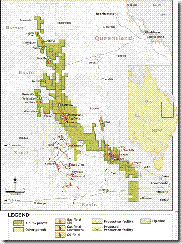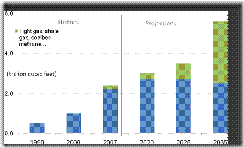Unconventional Gas Riles and Refigures the World Energy Market: The Pacific and Asia (Part II)
By Donald Hertzmark -- February 17, 2011In Part 1 of this series, the trends in U.S. unconventional gas output in were explored. The impacts on gas markets — $3–5/MMBtu — were noted. If unconventional gas puts pressure on LNG and Gazprom, can this supply and supplier turn to Asia as their new market? Maybe, and just for a while. (1)
1.1.1 Australia’s Experience with Coal Seam Gas
CSG accounts for almost 15% of Australia’s growing gas production, and as much as 30% of probable reserves. LNG plants based on CSG are slated to commence production in 2014, with production of 794 Bcf/y (~16.7 mtpa). Australia’s CSG is believed to occur roughly above shale gas basins, raising the possibility of further unconventional production. Figure 1 shows the CSG, conventional gas fields and transmission infrastructure in Australia’s Queensland State.
As was the case in the U.S., Australia’s development of its CSG occurred proximate to gas transmission infrastructure. The current CSG fields in Australia are just east of the Surat Basin gas fields, providing ready access to transmission and population centers.
Figure 1: Coal Seam Gas Resources and Infrastructure in Queensland, Australia
A peculiarity of unconventional gas, one that is shared with unconventional oil sources (shale oil, tar sands), is a long reserve lifetime. The unconventionals, at least using current technology, resemble mining or industrial operations more than they do traditional oilfield operations. This means moving a lot of material – water, overburden – and repeating the process continuously so as to maintain a constant rate of output. (1)
Such an approach differs significantly from traditional oil and gas where an up-front investment in output results in initial high rates of production, declining over time.
1.2 Will Unconventional Gas Compete With LNG in the Pacific?
Already, several Asian or Pacific countries are working on unconventional gas options. As noted above, Australia will enter the LNG market with about 16 mm tonnes/y (mtpa) based on the country’s coal seam gas in Queensland. LNG exports from Canada’s Horn River and Montney shales are expected to total more than 700 bcf/y eventually (5 mtpa rising to ~13 mtpa). Further, The US Department of State is attempting to mitigate some of the risks associated with a lack of one or more of the four critical success factors through its Global Shale Gas Initiative (2). Already the Department, in cooperation with the US Geological Survey, has signed up China, India, Poland, Morocco, Jordan, and soon Ukraine, for this unconventional gas effort. (3)
Canada and Australia will add the equivalent of Indonesia’s Bontang facility (21 mtpa) to regional markets.
Other unconventional gas production, probably starting with Indonesia and China, will bring equivalent volumes of gas to domestic markets in those countries.
1.2.1 Where Else in Asia Is There Unconventional Gas?
A flip response would be: where isn’t there unconventional gas? Seriously, with near term unconventional production in the Pacific Basin reaching more than 2 tcf/y, just from Australia and Canada, the impacts of unconventional gas in the Pacific may be even more profound than those in the Atlantic markets.
In addition to Australia and Canada unconventional gas is likely to enter local and regional energy markets based on production of CBM in Indonesia, shale gas in China and India, and CBM in China. India has already found shale gas in its infant exploration program. Resource estimates are not certain yet.
In China both shale gas and CBM have been found in the same geologic structures, reducing development and transportation costs for the output. The US Department of Energy concurs with optimistic estimates of China’s gas potential, projecting output to exceed 1 tcf/y by the next decade and more than 3 tcf/y by 2035.
As with the U.S. and Canada the DOE expects that unconventional gas resources will more than offset the decline in production from existing reserves.
Indonesia, once the world’s largest LNG exporter, is now beset by declining conventional fields. However, the country’s extensive coal reserves appear to harbor significant CBM. In fact, the country’s Ministry of Mines and Energy expects CBM to not only supply the domestic market but also to replace depleted offshore fields in Kalimantan (Borneo). Estimates of the high quality CBM resources exceed 300 tcf, and short term (before 2015) production of at least 0.5 tcf/y is likely, based on gas pipeline investments.
Indeed, Indonesia’s government expects unconventional gas to provide for a doubling of gas use in domestic markets over the next 15 years, with gas use increasing its market share.
2: Conventional and Unconventional Gas Production in China, 1990-2035
2: Conventional and Unconventional Gas Production in China, 1990-2035 (Source: US Department of Energy, International Energy Outlook 2010)
1.2.2 Is the Atlantic Experience About to Be Replicated in Asia and the Pacific?
The short answer is not yet. Although unconventional supplies are coming on line in Canada, Australia and, soon, China, Indonesia and India, not all of the four critical success factors for unconventional gas have yet been met. These success factors, based on North American and Australian experiences are as follows:
1. Experience with hydraulic fracturing as a “normal” feature of oil field activity;
2. A robust oil field service company roster, including, drill rigs and technical expertise;
3. The willingness of banks to finance small or medium sized companies in such endeavors; and
4. An adequate transmission network that can serve both conventional and unconventional producers.
Robust network capabilities can help producers and users obtain the best combinations of price and volume throughout the gas value chain. Without such flexibility Indonesia’s Kalimantan gas could end up committed to an LNG option that may not provide the greatest netback for the country in simple pricing terms. That is, if unconventional gas resources form a growing share of regional gas supplies this is likely to lead to a tougher market for LNG and, hence, lower wellhead prices.
China, with its virtually unlimited appetite for natural gas, is among the most eager to realize its unconventional gas. Unconventional gas (4) is already almost 10% of China’s domestic production (see Figure 2) and the DOE-EIA expects that figure to rise to more than 55% of total output within 25 years.
In order to challenge LNG as a pricing leader unconventional gas will need to achieve the following benchmarks:
· Production of Asian unconventional gas outside Australia and Canada exceeds the “lost” Indonesian LNG exports (~15 mtpa);
· Unconventional gas output in Indonesia can swing to LNG feed;
· China and India challenge oil-linked LNG prices based on domestic unconventional gas output; and
· Central Asian gas exporters (Turkemistan, Kazakhstan) accept gas-to-gas pricing basis.
With gas-to-gas competition in both the Atlantic and Pacific, can it be long before gas prices pressure oil markets?
Footnotes
(1) The “tail” for Australia’s CSG or US CBM has proved to have a positive slope in some cases.
(2) See www.state.gov/s/ciea/gsgi/index.htm for a description of the program.
(3) China and India are already invested in US unconventionals with more than $15 billion at risk in all.
(4) This is mostly CBM plus some tight gas.


Truly game-changing; I don’t think we’ve seen more than a little of the reshaping of things to come.
It is interesting that use of gas to replace other hydrocarbon fuels results in a 50% reduction in CO2 emissions. You’d think the Warmists would be happy! But they find the prospect defusing and confusing.
I personally regret the reduction of CO2 output, as it helps mitigate food shortages. Maybe gas-fired cement plants could make up the difference?